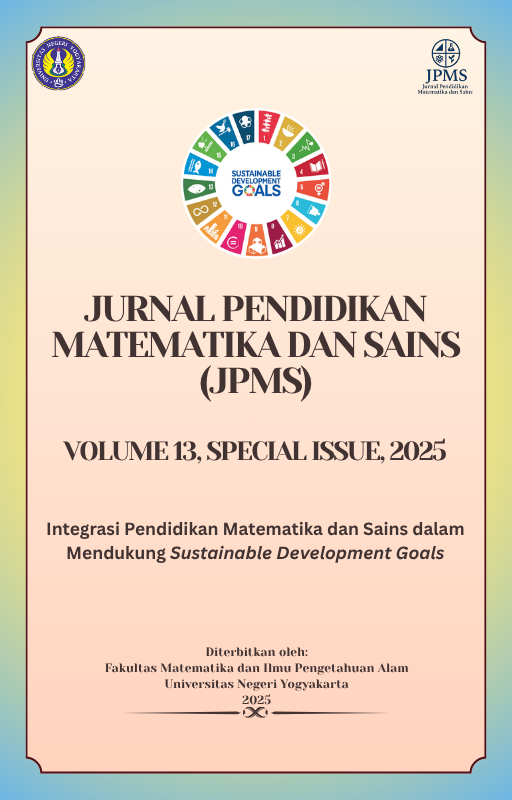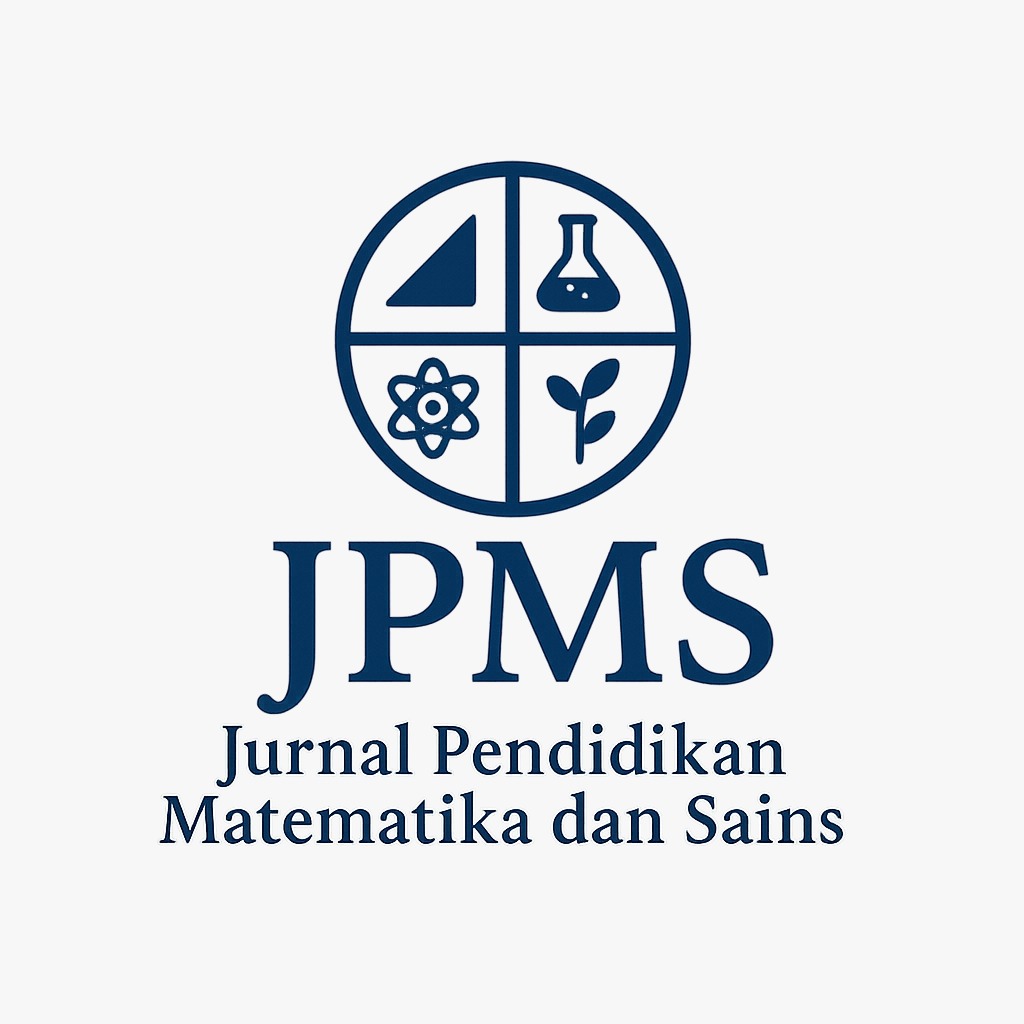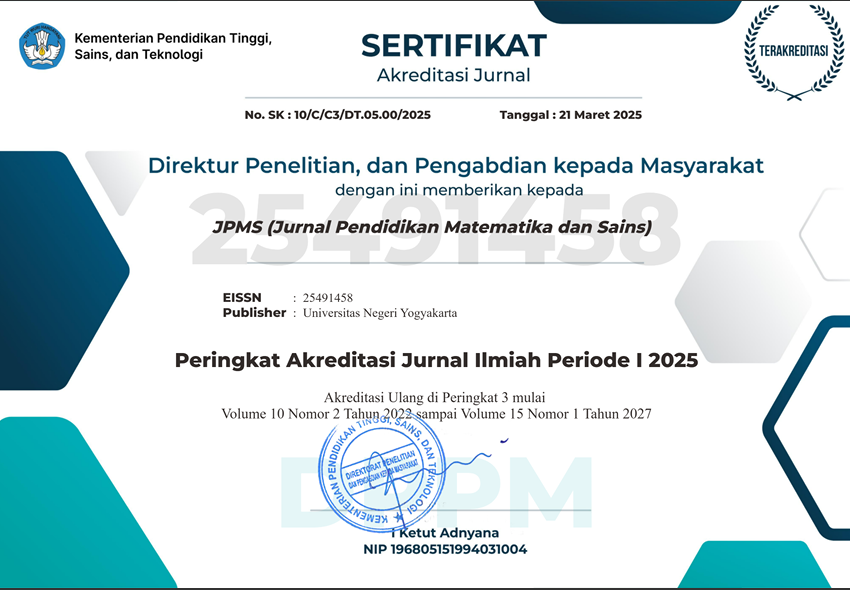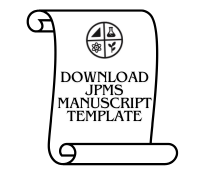REFECTO: GeoGebra-based Interactive Media for Light Waves Topic
DOI:
https://doi.org/10.21831/jpms.v13iSpecial_issue.89850Keywords:
Geogebra, Light waves, Physics learning, REFECTO, SimulationAbstract
REFECTO (Recognizing Fundamental Concepts Through Optics) is a GeoGebra-based instructional simulation developed to help students visually understand wave optics concepts, overcoming laboratory limitations while enhancing conceptual mastery and learning outcomes. An R&D framework, employing the 4D model (Define, Design, Develop) across three iterative phases. The Define phase identified pedagogical gaps through literature synthesis and stakeholder interviews. The Design phase integrated multimodal components aligned with learning needs. The Develop phase involved formative validation by five interdisciplinary experts, followed by phased trials with 31 Grade XI students and three physics teachers at SMA FI Jakarta. Data collection combined expert validation metrics and summative assessments. Rigorous analysis included Aiken’s validity index, Cronbach’s alpha reliability using a Likert scale response to measure feasibility and practicality, effectiveness was evaluated using a one-group pretest-posttest design, with data analyzed using n-Gain and Cohen’s d statistics via SPSS. REFECTO demonstrated robust (validity = 0.92; reliability = 0.76). Field testing showed high practicality based on student responses (validity = 0.90; reliability = 0.65) and teacher responses (validity = 0.85; reliability = 0.60), and statistically significant learning gains, with an N-Gain score of 84% (g = 0.84) and large effect size (d = 4.32). This study successfully operationalizes GeoGebra as a transformative tool for physics education, producing REFECTO a validated, scalable resource addressing critical infrastructure limitations in optics instruction. These findings underscore the potential of open-source platforms to bridge pedagogical divides, while supporting active learning as a strategy to improve student learning outcomes.
References
Ahmad, B., Rachmawati, Y., & Suryani, T. (2019). Efektivitas simulasi berbasis komputer dalam pembelajaran fisika di SMA. Jurnal Pendidikan Fisika, 12(1), 45–52.
Aiken, L. R. (1985). Three coefficients for analyzing the reliability and validity of ratings, educational and psychological measurument. Educational and Psychological Measurement, 45(1), 131–142.
Akhirni, A., & Mahmudi, A. (2015). Pengaruh pemanfaatan cabri 3d dan geogebra pada pembelajaran geometri ditinjau dari hasil belajar dan motivasi. Jurnal Pendidikan Matematika Dan Sains, 3(2), 91–100. https://doi.org/10.21831/jpms.v6i2.10922
Azizah, R., Yuliati, L., & Latifah, E. (2015). Kesulitan pemecahan masalah fisika pada siswa SMA. Jurnal Penelitian Fisika Dan Aplikasinya (JPFA), 5(2), 47. https://doi.org/10.1136/pgmj.53.620.343
Banda, H. J., & Nzabahimana, J. (2021). Effect of integrating physics education technology simulations on students’ conceptual understanding in physics: a review of literature. Physical Review Physics Education Research, 17(2), 23108. https://doi.org/10.1103/PhysRevPhysEducRes.17.023108
Batiibwe, M. S. K. (2024). Application of interactive software in classrooms: a case of geogebra in learning geometry in secondary schools in Uganda. Discover Education, 3(1). https://doi.org/10.1007/s44217-024-00291-8
Bello, A. (2022). Introduction to physics education technology (PhET) simulation Software. SSRN Electronic Journal. https://doi.org/10.2139/ssrn.4107639
Bhakat, P., Chakraborty, S., & Mandal, P. (2024). Tracking the motion of a simple pendulum with tracker. Resonance, 29(8), 1085–1093. https://doi.org/10.1007/s12045-024-1085-2
Bruner, J. S. (1966). Toward a Theory of Instruction (p. 10). President and Fellows of Harvard College.
Carli, M., Lippiello, S., Pantano, O., Perona, M., & Tormen, G. (2020). Testing students ability to use derivatives, integrals, and vectors in a purely mathematical context and in a physical context. Physical Review Physics Education Research, 16(1), 10111. https://doi.org/10.1103/PhysRevPhysEducRes.16.010111
Cvenić, K. M., Ivanjek, L., Planinić, M., SušAc, A., Jeličić, K., Hopf, M., & Srnka, C. (2021). Exploring secondary school students’ understanding of basic phenomena relating to wave optics. Journal of Physics: Conference Series, 1929(1), 012007. https://doi.org/10.1088/1742-6596/1929/1/012007
Dewi, G. N., Nor, M., & Irianti, M. (2023). Penggunaan media pembelajaran fisika vascak physics animation untuk meningkatkan pemahaman konsep siswa pada materi alat optik kelas xi sma negeri 3 bangko pusako. Journal on Education, 05(02), 4774–4782.
Faruq, M., Utomo, W., & Nindiasari, H. (2025). Pengaruh pbl-stad dalam meningkatkan hasil belajar matematika siswa the effect of pbl-stad in enhancing students ’ mathematics learning outcomes. Jurnal Pendidikan Matematika Dan Sains, 13(2), 398–408. https://doi.org/10.21831/jpms.v13i2.84682
Febriansyah, & Pujianto. (2023). Challenges of teaching optics in indonesian high schools. Journal of Science Education, 15(1), 45-60.
Fitra, A., & Sitorus, M. (2021). Pengaruh pembelajaran berbantuan aplikasi geogebra terhadap hasil belajar siswa di kelas viii smp kemala bhayangkari i medan. Jurnal Media Informatika, 2(2), 51–61. https://doi.org/10.55338/jumin.v2i2.694
Gaol, R. L. (2023). Pemanfaatan pelepah sawit dalam pembelajaran cermin di smp negeri 5 satu atap tanjung morawa. Jurnal Inovasi Pembelajaran Fisika (INPAFI), 60, 77–82.
Hasnain, A. F., Islam, J., Paosawatyanyong, B., & Wattanakasiwich, P. (2010). Investigation of conceptual understanding in optics. AIP Conference Proceedings, 252–255. https://doi.org/10.1063/1.3479882
Hohenwarter, M., & Fuchs, K.-J. (2022). Combination of dynamic geometry, algebra and calculus in the software system GeoGebra.
Humairoh, S., Suryadi, A., Solehat, D., & Ihsanuddin, M. (2025). Pengembangan kit smart-system with solar panel and sound sensor menggunakan pendekatan stem pada materi pengenalan instrumen digital development of smart-system kit with solar panel and sound sensor using stem approach on digital instrument introduction m. Jurnal Pendidikan Matematika Dan Sains, 13, 115–132. https://doi.org/10.21831/jpms.v13iSpecial_issue.88718
Juandi, D., Kusumah, Y. S., Tamur, M., Perbowo, K. S., & Wijaya, T. T. (2021). A meta-analysis of geogebra software decade of assisted mathematics learning: what to learn and where to go? Heliyon, 7(5), e06953. https://doi.org/10.1016/j.heliyon.2021.e06953
Kolář, P. (2019). GeoGebra for Secondary School Physics. Journal of Physics: Conference Series, 1223(1). https://doi.org/10.1088/1742-6596/1223/1/012008
Kordek, D., & Voda, P. (2024). GeoGebra and its applications - especially for teaching of geometrical optics. Journal of Physics: Conference Series, 2715(1). https://doi.org/10.1088/1742-6596/2715/1/012004
Lawhon, D. (1976). Instructional development for training teachers of exceptional children: a sourcebook. Journal of School Psychology, 14(1), 75. https://doi.org/10.1016/0022-4405(76)90066-2
Maskar, S., & Dewi, P. S. (2020). Praktikalitas dan efektifitas bahan ajar kalkulus berbasis daring berbantuan geogebra. Jurnal Cendekia : Jurnal Pendidikan Matematika, 4(2), 888–899. https://doi.org/10.31004/cendekia.v4i2.326
Mayer, R. E. (2009). Multimedia learning (2nd ed.). In The Management of Technical Change (Vol. 41). Cambridge University Press. https://doi.org/10.1057/9780230800601_4
Mellyzar, Sriyati, S., & Hernani. (2025). Evaluation of the environmental chemistry course using the cipp model: integrating sdgs and enhancing students’ environmental literacy. Jurnal Pendidikan Matematika Dan Sains, 13(1), 47–64. https://doi.org/10.21831/jpms.v13i1.81825http://journal.uny.ac.id/index.php/jpms
Mešić, V., Neumann, K., Aviani, I., Hasović, E., Boone, W. J., Erceg, N., Grubelnik, V., Sušac, A., Glamočić, D. S., Karuza, M., Vidak, A., AlihodŽić, A., & Repnik, R. (2019). Measuring students’ conceptual understanding of wave optics: a rasch modeling approach. Physical Review Physics Education Research, 15(1), 1–20. https://doi.org/10.1103/PhysRevPhysEducRes.15.010115
Munyaruhengeri, J. P. A., Umugiraneza, O., Ndagijimana, J. B., & Hakizimana, T. (2023). Potentials and limitations of geogebra in teaching and learning limits and continuity of functions at selected senior four rwandan secondary schools. Cogent Education, 10(2). https://doi.org/10.1080/2331186X.2023.2238469
Njonge, T. (2023). Influence of psychological well-being and school factors on delinquency , during the covid-19 period among secondary school students in selected schools in nakuru county : kenya. International Journal of Research and Innovation in Social Science, VII(2454), 1175–1189. https://doi.org/10.47772/IJRISS
Papp-Varga, Z. (2008). GeoGebra in mathematics teaching. Teaching Mathematics and Computer Science, 6, 101–110. https://doi.org/10.5485/tmcs.2008.r010
Pebriana, I. N., & Nuryaman, A. V. (2023). E-Modul berbasis inquiry learning terintegrasi stem dalam fisika : pengaruhnya terhadap penguasaan konsep impuls dan momentum stem integrated inquiry learning based e-module in physics : its impact on conceptual understanding of impulse and momentum. Jurnal Pendidikan Matematika Dan Sains, XI(1), 62–74. https://doi.org/10.21831/jpms.v7i2.39720
Pratama, F. I., Rohaeti, E., & Laksono, E. W. (2025). Building Sustainable Education with the Literacy and Research-oriented Cooperative Problem-based Learning: A Bridge in the Activeness of Chemistry Education Students. Jurnal Pendidikan Matematika Dan Sains, 13(Special_issue), 61–68. https://doi.org/10.21831/jpms.v13iSpecial_issue.88392
Prayitno, B. A., Fitriani, N., & Suryadi, J. (2023). Measuring the effectiveness of geogebra in teaching wave optics through cohen’s d analysis. Jurnal Pendidikan Fisika Indonesia, 19(2), 123–132. https://doi.org/https://doi.org/10.15294/jpf
Putri, A., & S. (2020). Pemanfaatan geogebra dalam pembelajaran matematika untuk meningkatkan pemahaman konsep siswa. Jurnal Pendidikan Matematika, 8(2), 121–130.
Riani Johan, J., Iriani, T., & Maulana, A. (2023). Penerapan Model Four-D dalam Pengembangan Media Video Keterampilan Mengajar Kelompok Kecil dan Perorangan. Jurnal Pendidikan West Science, 01(06), 372–378.
Rohmanasari, F., & Ermawati, F. U. (2020). Using four-tier multiple choice diagnostic test to identify misconception profile of 12th grade students in optical instrument concepts. Journal of Physics: Conference Series, 1491(1). https://doi.org/10.1088/1742-6596/1491/1/012011
Sabrina, N., Syarifah Nur, S., & Suanto, E. (2023). Validitas dan Praktikalitas E-Bahan Ajar Berbantuan GeoGebra. 6(4), 391–400.
SMF Jugessur, Y. (2022). Reliability and internal consistency of data: significance of calculating cronbach’s alpha coefficient in educational research. International Journal of Humanities and Social Science Invention (IJHSSI), 11(4), 12. https://doi.org/10.35629/7722-1104030914
Solvang, L., & Haglund, J. (2021). How can geogebra support physics education in upper-secondary school - a review. Physics Education, 56(5). https://doi.org/10.1088/1361-6552/ac03fb
Suprapto, N., Nandyansah, W., & Mubarok, H. (2020). An evaluation of the “picsar” research project: an augmented reality in physics learning. International Journal of Emerging Technologies in Learning, 15(10), 113–125. https://doi.org/10.3991/ijet.v15i10.12703
Szostak, R. (2011). Complex concepts into basic concepts. Journal of the American Society for Information Science and Technology, 62(11), 2247–2265. https://doi.org/10.1002/asi.21635
Tamam, B., & Dasari, D. (2021). The use of geogebra software in teaching mathematics. Journal of Physics: Conference Series, 1882(1). https://doi.org/10.1088/1742-6596/1882/1/012042
Tessmer, M. (1993). Planning and Conducting Formative Evaluations: Improving the Quality of Education and Training. United Kingdom: Psychology Press. https://books.google.co.id/books?id=eEsO-LvMS60C&printsec=frontcover&hl=id#v=onepage&q&f=true
Wan, T., Emigh, P. J., & Shaffer, P. S. (2019). Investigating how students relate inner products and quantum probabilities. Physical Review Physics Education Research, 15(1), 10117. https://doi.org/10.1103/PhysRevPhysEducRes.15.010117
Widyastuti, R. T., & Airlanda, G. S. (2020). Efektivitas model problem based learning terhadap kemampuan pemecahan masalah matematika siswa sekolah dasar. Jurnal Basicedu, 5(5), 1120–1129. https://journal.uii.ac.id/ajie/article/view/971
Yoyana, S., Guru, P., & Dasar, S. (2025). The Effect of Using Geoboard Media on Students ’ Mathematics Learning Outcomes in Plane Geometry Material. 13(2), 360–368.
Ziatdinov, R., & Valles, J. R. (2022). Synthesis of modeling, visualization, and programming in geogebra as an effective approach for teaching and learning stem topics. Mathematics, 10(3), 398. https://doi.org/10.3390/math10030398
Downloads
Published
How to Cite
Issue
Section
Citation Check
License

This work is licensed under a Creative Commons Attribution-ShareAlike 4.0 International License.
Jurnal Pendidikan Matematika dan Sains allows readers to read, download, copy, distribute, print, search, or link to its articles' full texts and allows readers to use them for any other lawful purpose. The journal allows the author(s) to hold the copyright without restrictions. Finally, the journal allows the author(s) to retain publishing rights without restrictions
- Authors are allowed to archive their submitted article in an open access repository
- Authors are allowed to archive the final published article in an open access repository with an acknowledgment of its initial publication in this journal

This work is licensed under a Creative Commons Attribution-ShareAlike 4.0 Generic License.





